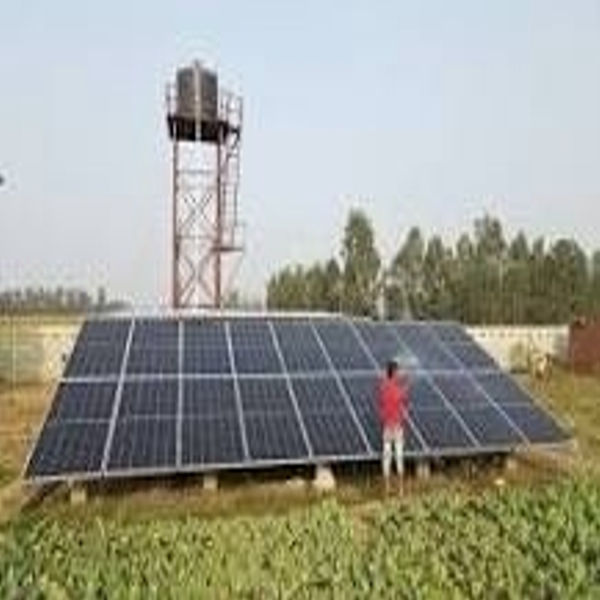SOLAR SYSTEM A solar energy system is a renewable energy solution that converts sunlight into electricity. Here’s a brief overview of the key components and concepts involved in solar power: Key Components: Solar Panels: Photovoltaic (PV) cells within the panels convert sunlight directly into electricity. Typically made of silicon and available in monocrystalline, polycrystalline, or thin-film types. Inverter: Converts DC (direct current) electricity produced by solar panels into AC (alternating current) electricity, which is used by most household and commercial appliances. Battery (optional): Stores excess energy generated during sunny periods for use at night or during cloudy days. Lithium-ion and Lead-Acid are common types of batteries used in solar systems. Charge Controller: Regulates the voltage and current coming from the solar panels to ensure batteries are charged safely without overcharging. Mounting System: Secures the solar panels to the roof, ground, or other surfaces. The angle and orientation are important for maximizing efficiency. Electrical Wiring and Safety Components: Connects all components together, ensuring proper flow of electricity and protecting the system from issues like overvoltage. Types of Solar Energy Systems: Grid-Tied Solar System: Connected to the utility grid; excess energy can be sent back to the grid, sometimes earning credits via net metering. Off-Grid Solar System: Not connected to the grid; typically used in remote areas. Requires a battery for energy storage. Hybrid Solar System: Combines grid-tied and off-grid setups, with batteries for storage and the ability to use the grid when necessary. Benefits: Environmentally Friendly: Solar power is clean, renewable, and reduces carbon footprint. Cost Savings: Can significantly lower electricity bills by generating your own power. Low Maintenance: Solar systems require minimal upkeep after installation. Drawbacks: Initial Cost: High installation costs, though they can be offset by savings over time. Weather Dependence: Performance can be affected by weather conditions and time of day.
Chat with us on WhatsApp
×
This is your website preview.
Currently it only shows your basic business info. Start adding relevant business details such as description, images and products or services to gain your customers attention by using Boost 360 android app / iOS App / web portal.
SOLAR SYSTEM A solar energy system is a renewa...

2025-03-28T06:56:52
SOLAR SYSTEM A solar energy system is a renewable energy solution that converts sunlight into electricity. Here’s a brief overview of the key components and concepts involved in solar power: Key Components: Solar Panels: Photovoltaic (PV) cells within the panels convert sunlight directly into electricity. Typically made of silicon and available in monocrystalline, polycrystalline, or thin-film types. Inverter: Converts DC (direct current) electricity produced by solar panels into AC (alternating current) electricity, which is used by most household and commercial appliances. Battery (optional): Stores excess energy generated during sunny periods for use at night or during cloudy days. Lithium-ion and Lead-Acid are common types of batteries used in solar systems. Charge Controller: Regulates the voltage and current coming from the solar panels to ensure batteries are charged safely without overcharging. Mounting System: Secures the solar panels to the roof, ground, or other surfaces. The angle and orientation are important for maximizing efficiency. Electrical Wiring and Safety Components: Connects all components together, ensuring proper flow of electricity and protecting the system from issues like overvoltage. Types of Solar Energy Systems: Grid-Tied Solar System: Connected to the utility grid; excess energy can be sent back to the grid, sometimes earning credits via net metering. Off-Grid Solar System: Not connected to the grid; typically used in remote areas. Requires a battery for energy storage. Hybrid Solar System: Combines grid-tied and off-grid setups, with batteries for storage and the ability to use the grid when necessary. Benefits: Environmentally Friendly: Solar power is clean, renewable, and reduces carbon footprint. Cost Savings: Can significantly lower electricity bills by generating your own power. Low Maintenance: Solar systems require minimal upkeep after installation. Drawbacks: Initial Cost: High installation costs, though they can be offset by savings over time. Weather Dependence: Performance can be affected by weather conditions and time of day.
2025-03-28T06:56:52
Keywords
- ensure batteries
- grid typically
- weather conditions
- offgrid setups
- earning credits
- overvoltage types
- roof ground
- charged safely
- current coming
- common types
- sunny periods
- monocrystalline polycrystalline
- concepts involved
- key components
- electricity heres
- converts sunlight
- solar panels
- solar system
- clean renewable
- solar energy system
- electricity typically made
- safety components connects
- renewable energy solution
- remote areas requires
- ensuring proper flow
- cloudy days lithiumion

Submit Your Enquiry